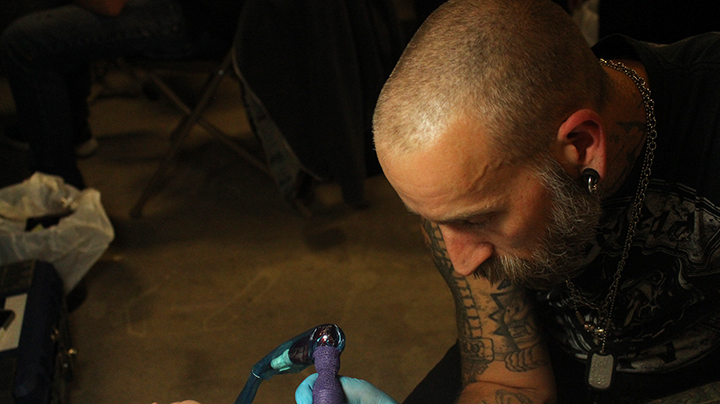Manny Landry from Harbourside Tattoo in Vancouver, BC tattoos an arm at the Windy City Tattoo Convention in Lethbridge on Sept. 16.

Windy City Tattoo Convention celebrated its 10th anniversary this year with acts and artists from all over the globe.
The convention, which celebrates tattoo artistry in Southern Alberta has been a huge draw over the years as a place for artists to meet, converse and potentially find new clients and hire new people for their shop.
This year’s convention brought over 130 artists and vendors to the exhibition grounds, a number which event coordinator, Will Woods says was growing each day and hard to keep track of.
“Anyone who puts on any type of event… they take a lot of work, they really do,” says Woods “Especially something like this…trying to organize that many artists, that many booths it takes a lot of work… I really start planning for next year right away.”
Due to an age-old stigma surrounding tattoos, people in previous years have claimed the festival to be “odd” and dismissed it as something “easy to put together some sort of that requires little work” says Woods.
For some time, many people have believed that a rise in and continuing acceptance of tattoos would fade away.
While some people do believe this, tattoos in Western Civilization started out as tiny anchors and animals on sailor’s feet to stabilize them during long journeys across the equator. Sailors used them as symbolism to show where they’ve been and even tattooed certain animals on their bodies to protect them, from rough waters, mainly pigs and roosters, on their bodies to protect them from rough waters.
Neither animal can swim, but because they were stored in buoyant crates, they were cargo that typically survived shipwreck.
Civil War soldiers garnered them as identification during the war so that their families could identify their bodies should something happen to them.
Some hints of tattoos initially popped up as far back as Ancient Egyptian times.
Mummies were being discovered, even recently, with tattooed eyelids and fingers.
Even farther back, Time magazine reports that in the mid-18th century, Native American women tattooed themselves to alleviate thing like toothaches and arthritis, as an ancient form of acupuncture.
Tattooing gained popularity when people began adding it to their skin in the west, which was a fashion statement inspired by the socialites of that time.
The significant stigma that used to be associated with tattoos has lessened recently with more and more individuals from all walks of like and all statuses having very visible tattoos all over their bodies. Orbax Klopek a one half performing duo “Monsters of Schlock” with his brother Sweet Pepper Klopek, says that having tattoos definitely shouldn’t make you bad person
“As we continue to go forward in this more and more people have tattoos and more and more people have very visible tattoos. From all walks of life, from every job possibility.”
Where tattoos used to be associated with a certain kind of person either criminal or otherwise now they can be used to express oneself or as a permanent form of art or tribute.



